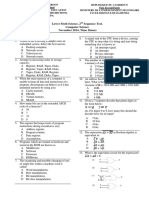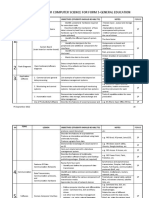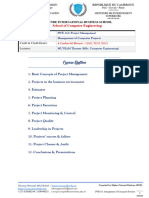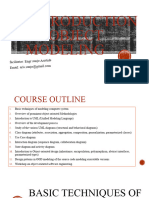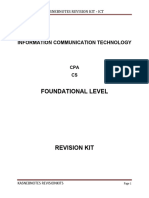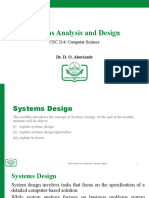Information System II – Merise – Year II Software Engineering
INFORMATION SYSTEMS II – MERISE
BY
Mr. CONSTANTINE N. MBUFUNG
DEPARTMENT OF SOFTWARE ENGINEERING
ISTAMA DOUALA
Mr. Ngong Constantine MSc Data Science – Tel: 678659025 / 693101501 - Page 1
Information System II – Merise – Year II Software Engineering
- Course Overview:
The future of computers and digital technology promises exciting challenges and opportunities.
Powerful software and hardware systems are changing the way people and organizations interact in
their daily life and on the internet. This course introduces you to the skills and concepts you need to
be prepared for this ever-changing digital world, including:
Information systems – how the critical parts of technology interact
Efficiency and effectiveness – how to maximize the use of technology
Data Models – Conceptual, Logical and Physical
Software Analysis and Development Methodologies - MERISE
Cloud computing
- Course objective:
In this course student will learn the following
Understand the role of information systems in organizations
Understand Data model – from conceptual to logical to physical
Understand how to apply SDLC methodologies to develop information systems
Implement information security measures
Use DSS to support decision-making
Stay updated on emerging technologies
- Course Assessment
Assignments
Projects
CA and Exams
- Reference Books
*
Mr. Ngong Constantine MSc Data Science – Tel: 678659025 / 693101501 - Page 2
Information System II – Merise – Year II Software Engineering
s/n Dates Content or Lessons Entry Time Exit Hour Total N° Signatures Observation
of Hrs
1 12-09-2024 Introduction of Information systems - MERISE 8H:00 12H:00 04
- Definitions of terms – Data, information, system,
information systems
- Components of information systems (hardware,
software, data, people, procedures)
- Roles information systems in organizations
Administrator
- Phases of SDLC (planning, analysis, design,
implementation, maintenance)
- Methodologies (waterfall, agile, prototyping)
- Introduction to databases, models (relational,
hierarchical, network), SQL, Database Design and
normalization
- Network Topologies (star, bus, ring), Internet and the
World Wide Web
- Information Security – threats to information
security (viruses, malware, hacking), security
measures(firewalls, encryption, access control)
- Decision Support Systems(DSS) – types of DSS (data-
driven, model-driven, knowledge-driven), data
mining and analytics
- Emerging Technologies – Cloud computing, Big Data,
AI
2 13-09-2024 Chapter 1: Data Model 8H:00 12H:00 04
- What is a Data model
- From Conceptual to Logical
Human – Computer Interface (HCI): Explain
what is HCI and why it is needed
Ergonomic Elements
Data Organization
Mr. Ngong Constantine MSc Data Science – Tel: 678659025 / 693101501 - Page 3
Information System II – Merise – Year II Software Engineering
3 19-09-2024 Conception of files or database 8H:00 12H:00 04
Coding
4 20-09-2024 Control 8H:00 12H:00 04
Process organization
Assignment – build an information system
for local companies in Douala
5 26-09-2024 From Logical to Physical 8H:00 12H:00 04
- Programming, test
- Programming best practice
6 27-09-2024 - Documentation and maintenance 8H:00 12H:00 04
7 03-10-2024 Methodology and software tools 8H:00 12H:00 04
- General presentation of the different methodologies
- Software tools
8 04-10-2024 MERISE 8H:00 12H:00 04
- What is MERISE
- Key components of MERISE
- Detail analysis using MERISE
- Assignment
9 10-10-2024 - Evaluation of the cost of the detail study and 8H:00 12H:00 04
development
- Usage of software tools in conceiving and developing
softwares
11-10-2024 - 36
ASSESSMENT: The continuous assessments, tests and quizzes will be awarded 40%, while the remaining 60% will be for the end of the Semester
Examination Score
Mr. Ngong Constantine MSc Data Science – Tel: 678659025 / 693101501 - Page 4
Information System II – Merise – Year II Software Engineering
Chapter 1: Introduction to Information System
Data, characteristics of data, types of data,
What is a system and Characteristics of systems
What is an information system
Phases in SDLC
1.1. Data, Characteristics of data, types of data
Data is the raw material of information systems. It refers to facts, observations, measurements, or
any other pieces of information that can be collected, processed, stored, and analyzed. Data can be
structured or unstructured, quantitative or qualitative, and can come from various sources, such as
sensors, databases, surveys, or social media.
Key characteristics of data:
Accuracy: Data should be correct and free from errors.
Completeness: Data should be comprehensive and include all relevant information.
Timeliness: Data should be current and up-to-date.
Consistency: Data should be consistent and free from contradictions.
Relevance: Data should be relevant to the purpose for which it is used.
Data can be classified into different types:
Numerical data: Represents quantities (e.g., age, income, temperature).
Categorical data: Represents categories or groups (e.g., gender, color, country).
Textual data: Represents written or spoken language (e.g., documents, emails, transcripts).
Multimedia data: Represents images, audio, video, or other non-textual formats.
Data is essential for organizations to make informed decisions, improve efficiency, and gain a
competitive advantage. Effective data management and analysis are crucial skills for professionals
working in information systems and related fields.
1.2. System and its Characteristics
Systems are interconnected sets of components that work together to achieve a specific goal or
objective. They can be found in various aspects of our lives, from biological systems like the human
body to technological systems like computers and networks.
Key characteristics of systems:
Interconnectedness: The components of a system are interdependent and interact with
each other.
Purpose: Systems exist to achieve a specific goal or objective.
Mr. Ngong Constantine MSc Data Science – Tel: 678659025 / 693101501 - Page 5
Information System II – Merise – Year II Software Engineering
Inputs and outputs: Systems receive inputs, process them, and produce outputs.
Feedback: Systems often have feedback mechanisms to adjust their behavior based on the
results they produce.
Examples of systems:
Biological systems: The human body, ecosystems, cells
Technological systems: Computers, networks, transportation systems
Social systems: Families, communities, organizations
Economic systems: Markets, industries, governments
Systems can be analyzed and understood using various frameworks and methodologies, such as:
Systems theory: A general framework for studying systems and their behavior.
Systems engineering: A discipline that focuses on the design, development, and maintenance
of complex systems.
Systems analysis: A process of breaking down a system into its components and studying their
interactions.
1.3. Information Systems
Information Systems (IS) is a field that focuses on the design, development, implementation and
management of information technology (IT) solutions to solve organizational problems and improve
efficiency.
Key components of Information Systems
- Hardware: The physical components of a computer system, such as the CPU, memory,
storage, devices, and peripherals
- Software: The programs and applications that run on a computer.
- Data: The raw facts and figures that are processed by information systems.
- People: The individuals who use and manage information systems.
- Procedures: The rules and guidelines for using information systems.
Role of Information Systems in Organizations
Information systems play a crucial role in organizations by:
- Improving decision-making: Providing timely and accurate information to support decision-
making
- Increase efficiency: Automating tasks and streamlining processes.
- Enhancing communication: Facilitating communication and collaboration among employees.
Mr. Ngong Constantine MSc Data Science – Tel: 678659025 / 693101501 - Page 6
Information System II – Merise – Year II Software Engineering
- Supporting business strategies: Aligning information systems with organizational goals and
objectives.
Types of Information Systems
- Transaction Processing Systems(TPS): Used for processing routine business transactions, such
as sales, purchases and payroll
- Management Information Systems (MIS): Provide managers with summarized information to
make informed decisions.
- Decision Support Systems (DSS): Help managers make complex decisions by analyzing data
and providing alternative solutions.
- Enterprise Resource Planning (ERP) Systems: Integrate various business processes and
functions to provide a comprehensive view of the organization.
- Customer Relationship Management (CRM) Systems: Manage interactions with customers to
improve customer satisfaction and loyalty.
Challenges and Opportunities in Information Systems
- Rapid Technological advancements: Keeping up with the latest technologies and trends
- Security threats: Protecting sensitive information from authorized access.
- Ethical considerations: Ensuring that information systems are used ethically and responsibly.
- Globalization: Managing information systems in a global context.
1.4 Data Vs Information
Data is raw facts and figures, often presented in a structured format. Information is the processed
data that has meaning and context.
Data
- Raw data – A spreadsheet filled with numbers and text
- Database : A structured collection of data
- Charts and graphs: Visual representations of data
Mr. Ngong Constantine MSc Data Science – Tel: 678659025 / 693101501 - Page 7
Information System II – Merise – Year II Software Engineering
Information
- Knowledge: The understanding of data
- Insights: New information derived from data analysis
- Decision-making: Using information to make informed choices.
1.5 Phases of the Systems Development Life Cycle (SDLC)
The Systems Development Life Cycle (SDLC) is a structured approach to developing information
systems. It consists of several phases that guide the process from planning to implementation and
maintenance.
Here are the common phases of SDLC:
1. Planning:
o Identify the problem: Determine the business need or opportunity that the system will
address.
Mr. Ngong Constantine MSc Data Science – Tel: 678659025 / 693101501 - Page 8
Information System II – Merise – Year II Software Engineering
o Conduct feasibility study: Assess the technical, economic, and operational feasibility
of the project.
o Define project scope: Determine the boundaries and objectives of the project.
o Create a project plan: Develop a timeline, budget, and resource allocation plan.
2. Analysis:
o Gather requirements: Identify the specific needs and expectations of users.
o Create data flow diagrams: Model the flow of data through the system.
o Develop process models: Describe the business processes to be automated.
o Create use case diagrams: Document the interactions between users and the system.
3. Design:
o Create system architecture: Define the overall structure and components of the
system.
o Design data structures: Design the database schema and data models.
o Develop user interface designs: Create mockups and prototypes of the user interface.
4. Implementation:
o Develop and test code: Write and test the system's code.
o Integrate components: Combine the different parts of the system.
o Convert data: Migrate existing data to the new system.
o Train users: Provide training to system users.
5. Testing:
o Unit testing: Test individual components of the system.
o Integration testing: Test how the components interact with each other.
o System testing: Test the entire system to ensure it meets requirements.
o User acceptance testing (UAT): Test the system by end-users to ensure it meets their
needs.
6. Deployment:
o Install the system: Deploy the system into the production environment.
o Provide support: Offer ongoing support and maintenance.
7. Maintenance:
o Monitor performance: Track the system's performance and identify issues.
o Make enhancements: Implement new features or improvements.
o Provide technical support: Assist users with problems or questions.
SDLC Methodologies: A Comparative Overview
The Systems Development Life Cycle (SDLC) provides a structured framework for developing
information systems. There are various methodologies within SDLC that guide the development
process. Here are some of the most common ones:
Waterfall Model
Linear approach: Each phase is completed sequentially before moving to the next.
Advantages: Simple to understand and manage, well-suited for smaller projects with clearly
defined requirements.
Mr. Ngong Constantine MSc Data Science – Tel: 678659025 / 693101501 - Page 9
Information System II – Merise – Year II Software Engineering
Disadvantages: Less flexible, difficult to accommodate changes during development, and may
not be suitable for large or complex projects.
Agile Methodologies
Iterative and incremental approach: Projects are divided into smaller iterations, and each
iteration delivers a working product.
Advantages: More flexible, adaptable to changing requirements, and promotes customer
involvement.
Disadvantages: Requires disciplined teams and effective communication, may not be suitable
for projects with strict deadlines or regulatory requirements.
Popular agile methodologies: Scrum, Kanban, Extreme Programming (XP)
Prototyping Model
Focus on early prototyping: Creates a working model of the system to gather feedback and
refine requirements before full development.
Advantages: Reduces risk, improves communication, and can help identify issues early in the
process.
Disadvantages: May lead to scope creep if prototypes are not well-managed, and can be time-
consuming if not used effectively.
Spiral Model
Iterative and risk-focused approach: Each iteration involves planning, risk analysis,
engineering, and evaluation.
Advantages: Suitable for large, complex projects with high risks, allows for early identification
and mitigation of risks.
Disadvantages: Can be complex to manage, and may require significant upfront planning.
Rapid Application Development (RAD)
Accelerated development approach: Emphasizes rapid prototyping and iterative
development.
Advantages: Fast development time, reduced costs, and early user feedback.
Disadvantages: May compromise quality or long-term maintainability if not managed
properly.
Choosing the Right Methodology
The best SDLC methodology depends on various factors, including:
Project size and complexity: Larger, more complex projects may benefit from iterative
approaches like agile or spiral.
Mr. Ngong Constantine MSc Data Science – Tel: 678659025 / 693101501 - Page 10
Information System II – Merise – Year II Software Engineering
Project requirements: Projects with well-defined requirements may be suitable for the
waterfall model, while projects with uncertain requirements may benefit from prototyping or
agile.
Organizational culture: The organization's culture and existing processes can influence the
choice of methodology.
Risk tolerance: The level of risk the organization is willing to accept will affect the choice of
methodology.
Significance of SDLC
1. Structured Approach:
Provides a systematic and structured approach to software development, reducing the
likelihood of errors and ensuring a smooth workflow.
2. Quality Assurance:
Incorporates various testing phases to identify and rectify defects, ensuring the final product
meets quality standards.
3. Efficient Resource Management:
Helps in optimizing resource utilization by defining clear roles, responsibilities, and
timelines.
4. Risk Management:
Enables early identification and mitigation of risks through feasibility studies, planning, and
continuous testing.
5. Improved Communication:
Enhances communication between stakeholders, as each phase has defined deliverables and
milestones.
Full Form of SDLC in Action
Consider the development of a mobile banking application:
1. Planning:
Define project goals, resources, and timelines for creating a secure and user-friendly mobile
banking app.
2. Analysis:
Gather requirements from users, including features like balance checking, fund transfers,
and mobile deposit capabilities.
3. Design:
Create a design blueprint that outlines the app’s structure, navigation, and security features.
4. Implementation (Coding):
Write the code for the mobile banking app, ensuring it integrates seamlessly with banking
systems.
5. Testing:
Conduct thorough testing, including unit tests for individual features and system tests for
the entire application.
Mr. Ngong Constantine MSc Data Science – Tel: 678659025 / 693101501 - Page 11
Information System II – Merise – Year II Software Engineering
6. Deployment:
Release the app to users, ensuring it is available on app stores and compatible with various
devices.
7. Maintenance:
Address any user-reported issues, fix bugs, and implement updates to enhance security and
features.
Advantages and Limitations
Advantages:
1. Structured Development:
Provides a structured approach to software development, reducing chaos and ensuring a
systematic workflow.
2. Quality Assurance:
Ensures that software goes through rigorous testing, leading to a higher quality final
product.
3. Risk Management:
Allows for early identification and mitigation of risks, preventing issues from escalating.
4. Improved Communication:
Enhances communication between developers, stakeholders, and users through clear
documentation and milestones.
Limitations:
1. Rigidity:
The structured nature of SDLC may be seen as rigid, especially in fast-paced environments
where flexibility is crucial.
2. Resource-Intensive:
Requires significant resources, both in terms of time and personnel, which might be a
challenge for smaller projects.
Mr. Ngong Constantine MSc Data Science – Tel: 678659025 / 693101501 - Page 12

























